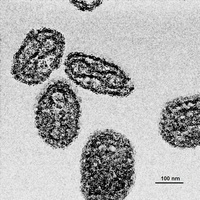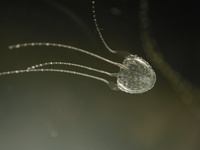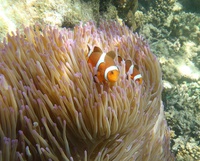Wacky climate impacts
Yvette Barry, 18 Sep 2013.
Chocolate rations, “crazy” fish and the spread of ancient diseases probably don’t spring to mind when you think of climate change. We scanned the news for reports of the more unusual impacts of rising temperatures.
-
Chocolate may become under threat (Image: Yvette Barry)
-
Could wiped-out diseases like small pox re-emerge as permafrost melts? (Image: PhD Dre at en.wikipedia)
-
Stingers like irukandji are heading further south along Australia's east coast. (Image: Jamie Seymour, James Cook University)
-
Will Nemo need to find a new home? As seas get warmer, sea anemones are experiencing bleaching and decline (image: Yvette Barry).
Chocolate and coffee rations?
Here's yet another good reason to fear climate change: coffee and chocolate may become luxury items “if farmers can’t adapt to rising temperatures”, writes The Guardian. Starbucks Coffee head of sustainability Jim Hanna told the newspaper that climate change is "a potentially significant risk to our supply chain". Already coffee farmers in Central America are seeing more severe weather and resistant bugs reduce crop yields, he said.
And the outlook for the cocoa bean is not so sweet either, according to a study by scientists at the International Center For Tropical Agriculture (CIAT). Half of the world’s cocoa beans come from West Africa, which will be too hot to grow “chocolate” by 2030. The resulting cocao glut will likely send chocolate prices soaring. If panic is gripping you already, relax. The Huffington Post predicts that scientists will be able to develop a heat-tolerant cocoa plant by then.
Carbon dioxide may drive fish crazy
If the idea of chocolate rations drives you mad, then spare a thought for marine fish. Carbon dioxide emissions are driving fish “crazy”, reports Science Daily. Carbon dioxide is pumped out by human activities - think: factories, cars and farming cows. High levels not only raise global temperatures, but also this gas is absorbed by the ocean. This changes the sea's pH in a process called 'acidification'. A team from the ARC Centre of Excellence for Coral Reef Studies and James Cook University found that increasing carbon dioxide levels dulled fishes’ sense of smell and hearing, leading to odd behaviour. “They were confused and no longer avoided reef sounds during the day. Being attracted to reefs during daylight would make them easy meat for predators,” said Professor Philip Munday, part of the research team.
Release of ancient diseases
It sounds like the plot of a B-grade horror movie: a deadly disease is released from ancient bodies uncovered in Siberia’s melting permafrost. Live Science reported that global warming is melting the layer of permanently frozen soil in places like Siberia. And the thawing tundra is revealing preserved bodies from the past. Scientists fear that as more and more ancient corpses are uncovered, they could release dormant diseases like smallpox.
Attack of the jellyfish
You’ve heard of melting sea ice and sea level rise. But invading jellyfish? As oceans become warmer, jellyfish are expected to thrive and expand their marine postcodes. One example, reported by The Daily Telegraph, is the invasion of Australian spotted jellyfish (Phyllorhiza punctata) in Spain. This forced beach closures and many beachgoers were treated for stings. Scientists believe the Aussie jellyfish took an overseas holiday in response to climate change, pollution and fishing pressures.
Closer to home, ABC radio reported that warming seas could explain the massive boost in jellyfish numbers around Australia last summer. The marine heatwave even saw outbreaks of poisonous irukandji jellyfish stings as far south as Fraser Island in Queensland, which marine scientists say isn't normally considered a danger zone for irukandji.
Finding Nemo a home
Still in the oceans, the much-loved clownfish a.k.a “Nemo” may lose his home, wrote Science Alert. Marine scientists have revealed that sea anemones, a clownfish’s main shelter, are experiencing bleaching and decline due to rising water temperatures. “Bleaching causes the loss of anemonefish, like nemos, which have nowhere to hide and without the anemones to protect them are quickly gobbled up by predators,” said Dr Ashley Frisch, again from the ARC Centre of Excellence for Coral Reef Studies at James Cook University.















